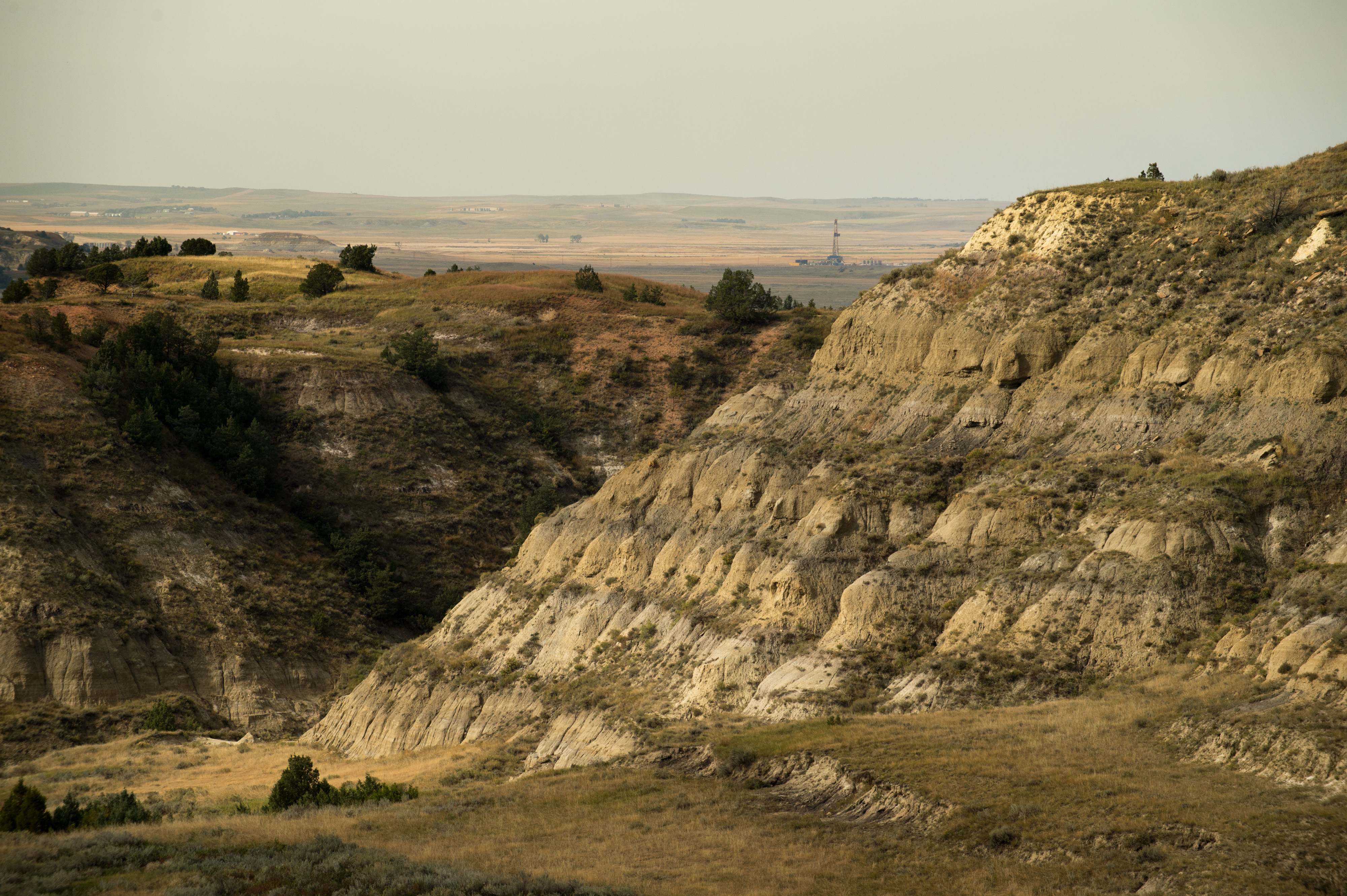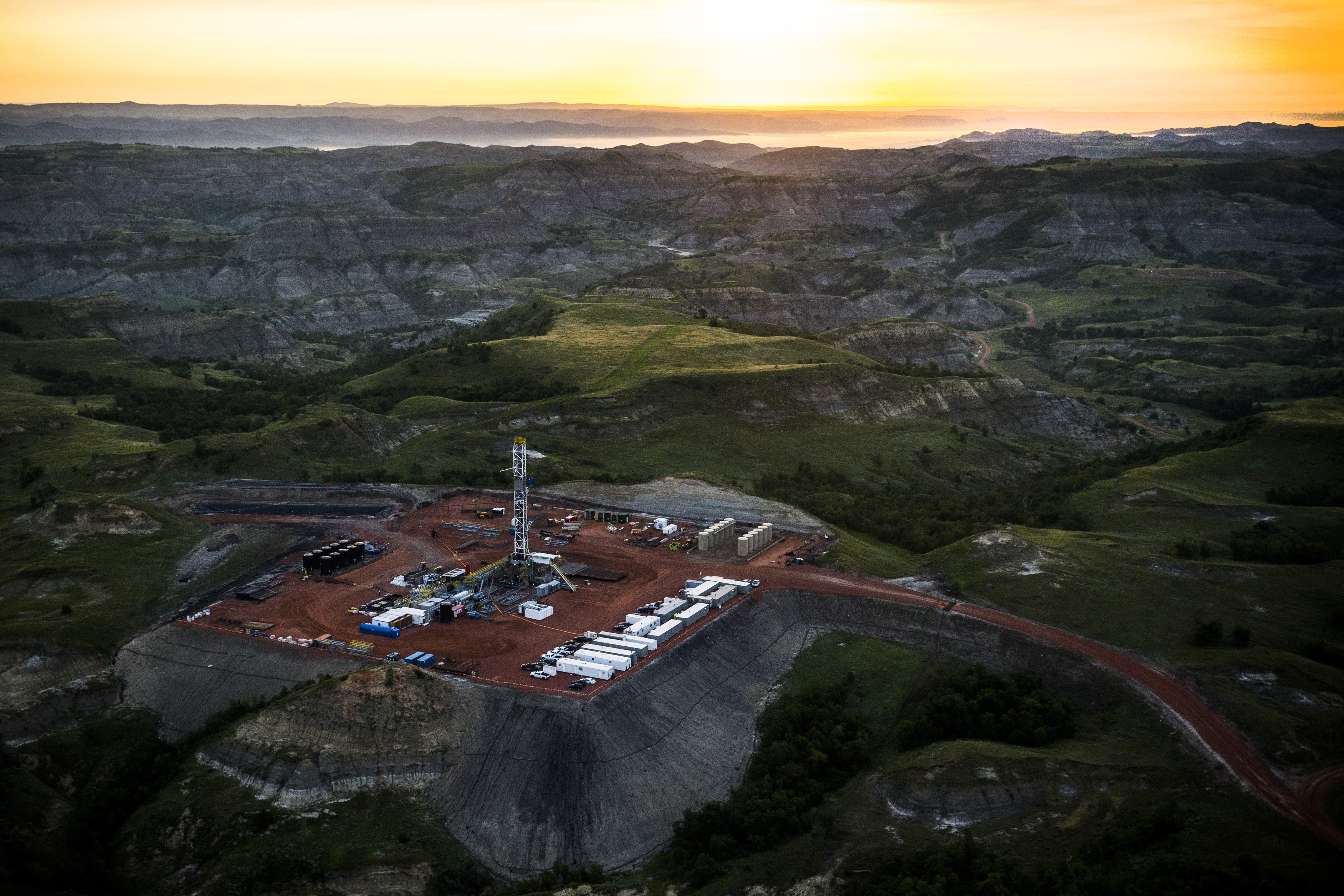This is part three of ThinkProgress’s State of Conflicted Interest series.
In 2014, less than five years after horizontal drilling and hydraulic fracturing turned the hills and prairies of the Bakken formation into one of the busiest oilfields in the world, North Dakota had nearly 200 active wells operating throughout the state.
But trying to ensure that the rapidly expanding oil boom adhered to environmental laws fell to several different officials within multiple state agencies because North Dakota is one of the only states in the country that lacks a standalone environmental agency in charge of state-level regulations.
Only three other states lack an agency that deals exclusively with environmental protection: Kansas, Colorado, and South Carolina. North Dakota is the only state that doesn’t even mention the word “environment” in its agency’s name — instead, environmental regulation is housed under the health department, while certain regulations are under the purview of the industrial commission.

That’s set to change in 2019, thanks to a law passed by the state legislature last year establishing the creation of the North Dakota Department of Environmental Quality. The current environmental subsection will break off to form its own, independent agency, with the two main environmental advisory boards — focused on air pollution and water issues — merge to form one main board.
But if moving environmental protection under one agency means a more streamlined — and, supporters say, visible — presence for environmental regulation in North Dakota, it could also come with its own set of pitfalls. In creating a separate agency, the legislature also mandated that the environmental advisory board be filled with representatives from powerful industries like oil and gas — leaving some to fear that the new chapter of environmental protection in North Dakota will be open to political influence.
Inspecting the Bakken boom
According to David Glatt, the current environment section chief for the state’s health department, the need for a separate environmental agency had been discussed for years, but became a pressing issue during the last oil boom, which saw hundreds of wells spring up across the Bakken formation starting in the late 2000s.
“When you’re tied with a bigger department, like the health department, there are a lot of priorities competing for resources,” Glatt told ThinkProgress. “By having our own agency, it allows us to set and identify our own priorities.”
Not having an agency dedicated to environmental regulation isn’t necessarily a problem, according to William Delmore, an attorney who worked for three decades in North Dakota environmental enforcement. At times throughout Delmore’s career, he witnessed the head of the health department’s environment subsection function as overall department head, placing an unwritten emphasis on environmental regulation and enforcement across the agency.

But when hundreds of oil wells sprung up across the state — bringing in tens of thousands of new workers and doubling oil output to more than 575,000 barrels a day in a the span of a few years — keeping environmental enforcement buried within the health department no longer seemed tenable.
“Overall, the Bakken oil play really coming into prominence, the environmental issues were raised to a higher level,” Glatt said. “We really needed that visibility, not being buried in another agency but being our own agency, so people knew there was an environmental agency addressing [any issues].”
But if the Bakken oil boom emphasized the relative invisibility of the North Dakota environmental section, it revealed something else in harsh relief: the difficulty of keeping up environmental enforcement during an unexpected oil boom.
A 2012 ProPublica article detailing environmental enforcement during the Bakken boom noted that in 2011, oil companies reported more than 1,000 accidental releases of oil, drilling wastewater, or other fluids. Most of those spills were small, but some were quite large, totaling more than one million gallons. But between 2009 and 2012, environmental enforcement officers in the state issued fewer than 50 disciplinary actions for illegal drilling activities, including spills and accidental releases.
“I’m not sure anybody was prepared for the boom,” Delmore said. “[The environmental section] certainly do not have the ability to inspect. They can’t inspect the pipelines, they can barely look at individual job sites.”
In comparison to other oil-producing states, like Oklahoma or Pennsylvania, North Dakota actually has a fairly high number of inspectors for every oil well (as of 2012, the state had 1 inspector for every 359 wells, according to E&E News). In 2011, the state legislature passed a law allowing the industrial commission to hire three more inspectors, and another two if the number of wells in the state were to reach 9,300. That would have translated to one inspector for every 372 wells — one of the best ratios in the country.

Still, thousands of spills in a single year — even small spills — takes its toll on the surrounding environment. Wastewater from hydraulic fracturing, or fracking, is often high in salt and can be laced with carcinogenic chemicals and heavy metals. And while spilled oil eventually starts to break down organically, wastewater — and the associated chemicals — can persist for years in water and soil.
A standalone agency
In 2015, North Dakota’s oil industry suffered a major downturn, precipitated by declining oil prices. But production in the Bakken region has started to pick up again, coinciding with the move to create a standalone department of environmental quality.
The bill creating the department passed easily in both the state house and senate, but not every lawmaker was supportive of the idea. In the senate, all nine Democrats voted against the bill, joined by seven Republicans. In the house, eight Democrats and 15 Republicans voted against the bill.
Chief among the criticism was the sense that the bill was rushed through the legislature, given only a 90-minute hearing in committee before being recommended for a full vote. But critics also worry about the bill’s creation of a politically-appointed cabinet position — a DEQ secretary — as well as an advisory board of 13 representatives mainly from industry, which would help direct the department’s priorities.
In an email to ThinkProgress, State Reprenstative Gretchen Dobervich (D), whose district includes Fargo, said that while the bill created another cabinet-level appointment and advisory board, it did little to ensure that those positions would be dedicated to environmental quality “assessment, policy or assurance.”
“To date I have not found an advisory committee membership list, announcement regarding applying for membership or any meeting minutes of the committee,” Dobervich, who voted against the bill, said.
Of the board’s 13 members, only three — the state engineer, state geologist, and director of the North Dakota Game and Fish Department — would not be appointed by the governor. The remaining 10 positions — eight of which are set aside for industry representatives — are left to the governor’s discretion, and thus open to political and private influence.
Industry influence
North Dakota Gov. Doug Burgum (R) has a tech industry background and has claimed to be “independent of the special interests,” though he comes from a family with financial ties to agribusiness. Burgum also received more than $100,000 in political donations from oil company executives during his gubernatorial campaign in 2016, despite claiming that oil company donations given to his Republican opponent in the primary constituted a potential conflict of interest problem.
“If you’re a member of the [North Dakota Industrial Commission] and you’re asking for someone’s support and you regulate that industry and they know you’re going to continue to regulate them, think about the power dynamic,” Burgum told the Bismarck Tribune in May of 2016.
Still, Burgum’s potential conflicts of interest seem to pale in comparison to former Gov. Jack Dalrymple (R), who shepherded the state through the oil boom of the late 2000s. While in office — and in charge of making certain regulatory decisions involving the oil and gas industry in the state — Dalrymple owned stock in Exxon, which in turn owned a company that sought permission to drill 100 feet from a national park.

Dalrymple’s connections to the oil industry didn’t end with his Exxon stock. In 2014, the New York Times reported that his 2012 reelection campaign received $550,000 from oil-related executives, lawyers, and political action committees, including $93,000 from companies directly related to a controversial oil production unit that Dalrymple signed off on while he was actively receiving campaign donations.
David C. Thompson, a lawyer in Grand Forks, North Dakota, told the Times that “our elected officials regulate companies they get contributions from and companies they own stock in.”
But in forming a standalone DEQ advisory board with 10 slots open for political appointees, it won’t just be elected officials regulating companies — it will be unelected citizens, chosen at the discretion of the governor, who will make decisions about the direction of environmental enforcement in North Dakota.
To some, the change would merely codify industry influence over environmental regulations. From Delmore’s perspective, environmental enforcement in North Dakota — once rooted in science and law over politics — has become increasingly fraught in recent years, as industry and conservative interests have pushed to cast environmental regulation as an anathema to economic growth.
“If where you come from is more growth, more development, that’s the way you’re going to see environmental protection,” Delmore said. “I never saw any of the divisions as wild treehuggers. They were doing their job, basing it off of data and national and state standards. But now, if anything is tried to be done enforcement wise, it’s seen that way.”
According to the Grand Forks Herald, environmental enforcement in North Dakota has fallen well below the national average, with just two percent of environmental violations met with enforcement (compared to 16 percent nationally). A 2011 report from the EPA’s Office of Inspector General found that between 2003 and 2009, the state assessed no penalties against known violators of the Clean Water Act, and noted that the state is often “philosophically opposed” to issuing enforcement actions.
Glatt says that the philosophy of environmental enforcement in North Dakota isn’t so much an opposition to penalties, but a preference for “compliance and communication.”
Glatt said that environmental enforcement officers in the state try to make a point of getting out in the field and sitting down with industry, and that “90 percent of the time we come out with a good solution.”
The environmental section, Glatt adds, “is very much tied to science and the law.”
But some outside observers are concerned that the future DEQ — with a politically-appointed head and an advisory board with so many ties to industry — could change that culture.
“I think environmental enforcement in North Dakota has become too reliant on outside pressure,” Delmore said. “It doesn’t matter if you’re a pro-industrial state or an anti-industrial state. If sulfur dioxide affects your lungs, it affects your lungs. It doesn’t matter what you believe. It affects you and it affects your kids. And that’s what you depend on environmental enforcers to protect you from.”


